Design as a capability for innovation and competitive advantage has been on the radar with business leaders for many years now. Way back in 2004 two designers, Tim Brown and David Kelley of IDEO, made the cover of Business Week. That’s over 15 years ago now, from a pre-iPhone era. Essentially the digital equivalent of the stone age.
Between 2005 and 2015 we’ve also had organisations such as the Design Management Institute (DMI) creating the Design Value Index (DVI), an experiment in measuring how much value design creates for businesses. The DMI invested $10,000 dollars in design-centric companies — those who had made significant investment and structural support for design — such as Apple, IBM, Nike, and Disney.
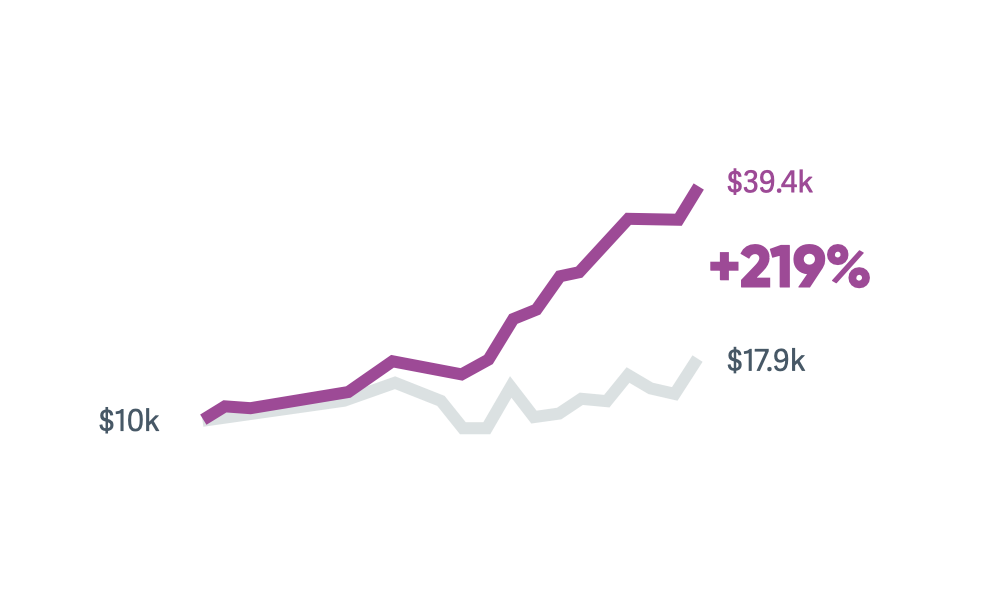
The $10,000 fund was then compared against one of the major US stock market indices to track performance of these design-centric companies against the broader market. While the market grew by almost 80%, the DVI-listed companies grew by nearly 300% in the same period.
This result surely demonstrates that design is valuable. So why aren’t we living in a design utopia? Why do most companies feel as though they have an immature understanding of design? That very few stakeholders are fully invested and committed to it?
Based on my experiences, I’ve seen a few common recurring themes in the struggle designers are facing within organisations. Names have been changed to protect the innocent.
Scenario 1: The Hooli problem
The first organisation, Hooli, has a really sophisticated technology setup. They know everything there is to know about Agile, DevOps and continuous delivery, having optimised their development cycles within an inch of their life. They’re as fast as they can possibly be, with hourly updates as needed, and numerous updates daily. But look a bit closer and something isn’t quite right.
Firstly, the design team is hugely outnumbered in comparison to their engineering colleagues, and even though they sit together as part of a cross-functional team they have no clout and no say. Design is in service to Technology and Engineering, and isn’t represented in any significant way higher up the food chain of the organisation, in the boardroom and where the big decisions happen.
Also, because everything is done so fast, paradoxically nobody has time to worry about whether or not they’re shipping things the customers want or need. There’s a rudimentary amount of usability testing but fixing anything that crops up isn’t factored into the release schedule. The user experience suffers as stuff gets pushed live without any proper consideration to the quality.
Speed is paramount, even if that means delivering shit fast, and everybody is too busy delivering to step back and think about more strategic challenges or the coherence of their customer experience across the different channels.
Their motto is “Design just slows us down”. This is Design by Engineering.
Scenario 2: The Wayne Enterprises problem
Wayne Enterprises are an established market leader looking to push the boundaries within their sector, and keen to disrupt their industry by bringing new and exciting products to market. They have a lot of investment, they pay huge salaries, and money isn’t a problem. But as they are a publicly-traded company, they are obsessed about the impact any decision has on their shareholders, and as a result their culture is obsessed with the short-term impact on the bottom line.
Analytics rule supreme. They believe everything that can be measured, should be measured. From even the smallest change to a purchasing funnel, to larger challenges of migrating from one business model to another, stakeholders always ask: What is the return on investment (ROI)?
Because of this, their team of highly (over)paid contract designers struggle to get any buy-in on anything. The team is paralysed by the demand to provide evidence for every single subjective or qualitative improvement in the user experience. Because brand loyalty and customer satisfaction are difficult to both quantify and affect in a short timeframe, none of the more ambitious customer-centric projects ever get off the ground. Nobody is interested in committing the budget unless they can quantify the returns. Despite all the ambition to innovate and disrupt their market, the rhetoric is hugely misleading — they are trapped by numbers and risk averse.
Unfortunately, this means the design team only ever optimise around what they know. Poring over analytics and hypothesising how to improve conversion by marginal percentages. They’re at the mercy of the local maxima — optimising existing design solutions until they’re drained of any more gains, while missing the bigger opportunities to reimagine something with greater potential.
Their motto is “I can’t see the ROI of design”. This is Design by Business Case.
Scenario 3: The Cyberdyne Systems problem
You may have heard of Cyberdyne. They’re a highly secretive but much publicised startup working on some ‘exciting’, progressive and innovative AI solutions to automation. An ideological organisation earnestly believing it is making the world a better place. (Big fans of the ‘opportunities’ provided by a global pandemic.)
Design here is both tactical and practical. Designers are used to add the final touches to marketing websites, presentation decks and so on. Designers don’t have any say in the design of their AI systems. Their logo probably wasn’t even done by a designer because it looks terrible. The sad truth is that there is no organisational malice behind these actions.
They have just always understood design to be the icing on the cake. It’s the aesthetic surface layer and nothing more. It seems absurd to them that a designer would be able to help them with their product engineering or execution of a business strategy.
Their motto is: “Less thinking. More colouring in.” This is Design by Naivety.
Design’s Iron Triangle
The three companies described above obviously aren’t real, but exaggerated archetypes we can surely all identify with. Their problems, however, are very real, and seem to be universal to design:
- Is design efficient enough? How much time and resources does it take to design?
- Is design profitable enough? How much money do we need to spend on it to see a valuable return on investment?
- Is design effective enough? Is the quality and scope of what we’re doing enough to satisfy customers or users? To meet their needs, goals and ambitions? We can change the colour of a button sure, but are we even making a product they’d use? Are we designing the right thing?
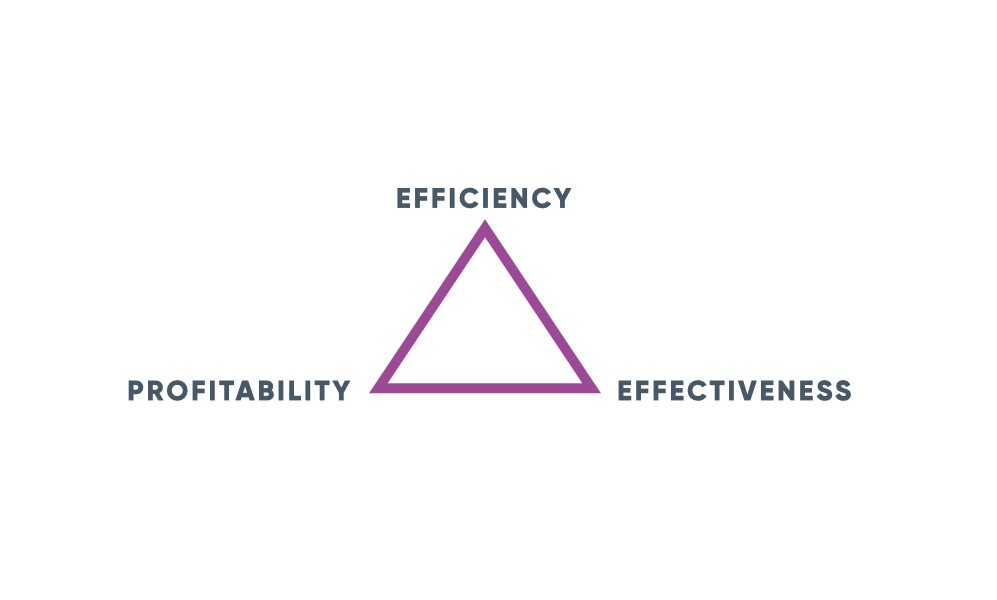
And of course these are universal considerations of design, because they’re also the same universal success factors to balance in any organisation: time, money and quality.
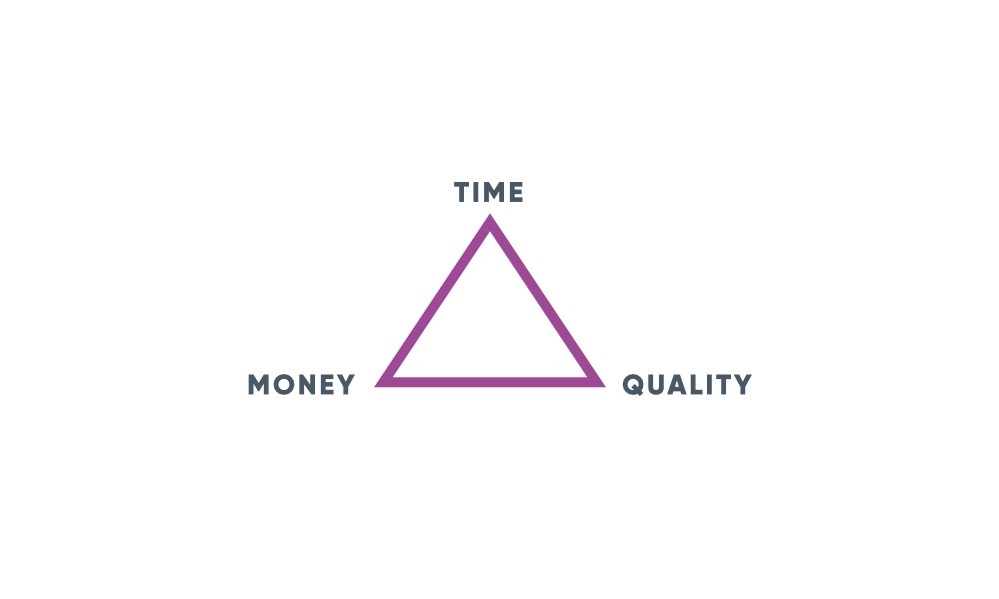
Changing one factor has an impact on the other factors. For instance, if you have a much bigger ambition of scope or quality to what you’re trying to achieve, that comes with a bigger price tag or a greater effort. Equally, spending less time will save money but impact the scale of what is being delivered. You may have heard of this as “pick two”: You can have it fast, cheap, or good, but not all three. You may have heard of this model as the Iron Triangle or the Project Management Triangle.
Looking through this lens, it explains why the most common challenges we see at companies trying to design better, are actually the universal challenges faced by all companies; a perpetual tradeoff between time, money and ambition.
No-one has achieved the perfect design team, or process, or outcome, because the constraints demand that you can only ever optimise for two of the three factors.
- Do you want it fast and cheap by sacrificing the extent of its qualities, whether that be scope, scale or finish?
- Do you want it fast and to a high standard by paying more?
- Or do you want to achieve the most ambitious quality and scope whatever the cost, at the price of it taking longer to deliver?
It’s no coincidence that a similar triangle of interdependent constraints exists elsewhere.
Critical Success Factors
It was Bill Moggridge and IDEO in the early 00’s that first coined the Design Thinking mantra of the three factors considered vital ingredients to the success of any product or service:
- Feasibility: Can we make this happen?
- Viability: Can the company profit economically from this?
- Desirability: Do users or customers or people want or need this?
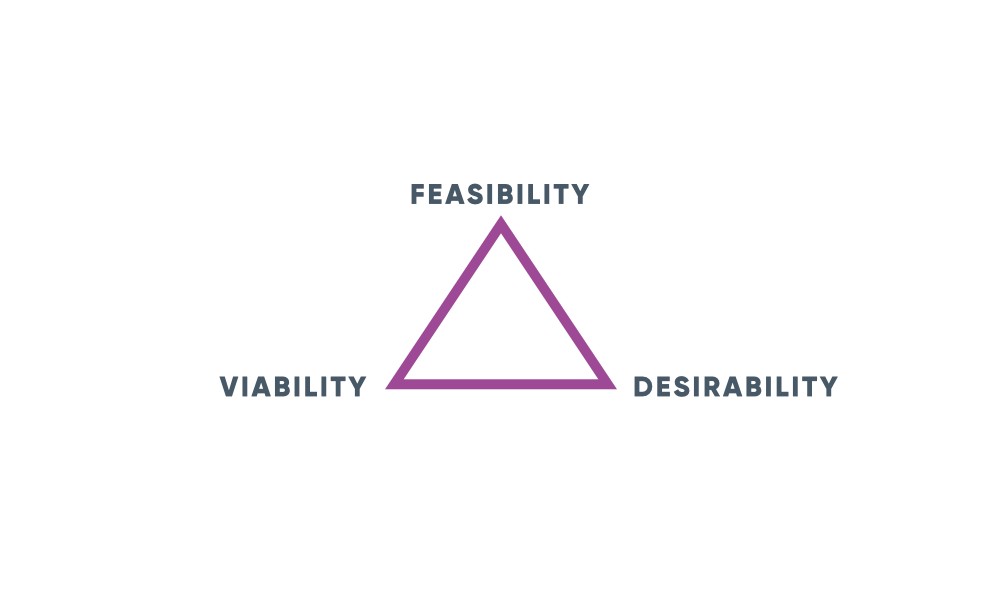
You could also call these technology needs, business needs and user needs. Most companies typically assign responsibility for each of these factors to specific areas of the business: Engineering, Product or Strategy, Design or Marketing, respectively.
Within the conceptual model of this Iron Triangle lies a potential model to help explore the challenges and tradeoffs good design needs to thrive.
Engineering teams are responsible for technology needs, ensuring solutions are feasible. Because the team’s primary constraint is the effort (i.e. time) required for the solution, they have the biggest influence on how efficiently the organisation solves design problems. Who hasn’t heard the development mantra “anything is possible given enough time”?
Product or Strategy teams are responsible for business needs, ensuring solutions are viable. Because the team’s primary constraint is the cost, or cost-benefit ratio, of the solution, they should have the biggest influence in how profitably the organisation solves design problems. In other words, how it maximises value from what it does.
Finally, Design or Marketing teams are responsible for user needs, ensuring solutions are desirable to potential or existing customers. Because the team’s primary constraint is the quality, or qualities, of the solution, they should have the biggest influence in how effectively the organisation solves design problems, in terms of meeting customer expectations and ensuring the best product-market fit.
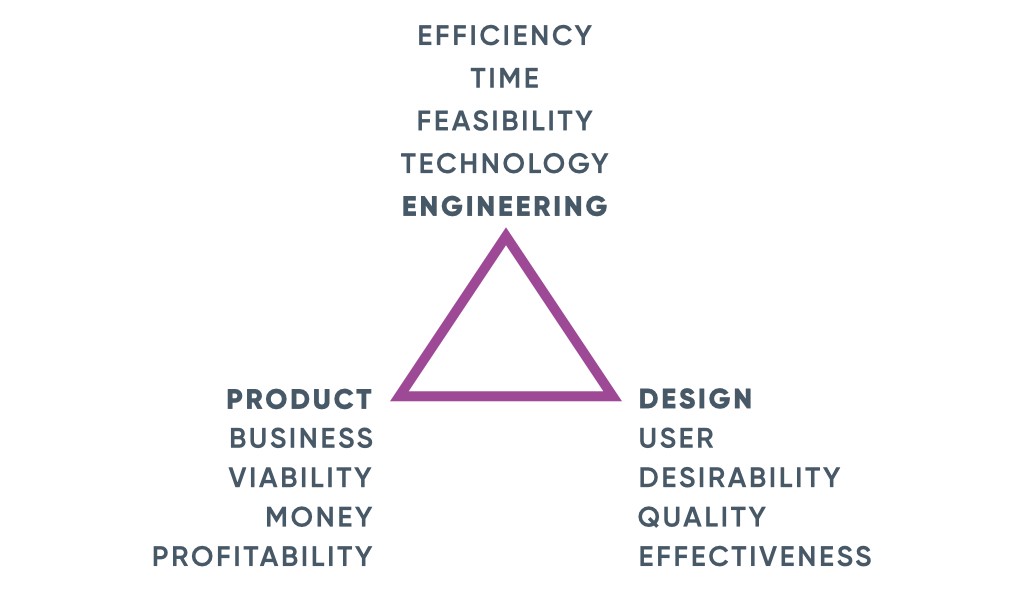
When these constraints are not in harmony, which they rarely are, you see a symptom of one or more of them negatively affecting the design outcomes. Organisations typically assign accountabilities at a departmental level, and when they do so they are giving focus to one of these constraints at the expense of the other two.
So when you experience design challenges, you are actually seeing a reflection of an organisational bias or emphasis towards one department over another. We are exposed to what is truly valued at the organisation, and witnessing where the greatest power and influence lies, intended or otherwise.
Organisations which face Hooli problems are struggling to get Design to work with Engineering and Technology teams in an efficient manner. Design is perceived as taking too long.
Organisations with Wayne Enterprises problems are struggling to get Design to work with the wider business to demonstrate how it can create new value and competitive advantage. Design isn’t obviously and transparently benefiting the bottom line.
And organisations with Cyberdyne problems have yet to appreciate or maximise customer-centric design at all. Design is just an aesthetic veneer before you put a product to market. The understanding of design itself is immature.
Organisational structures and hierarchies have a dramatic effect on culture and, by extension, the challenges relating to design. Culture is the greatest influencer on an organisation’s ability to be mature at design. Therefore in order to know how to tackle design challenges where you work, and to improve the outcomes of design, you first need to start with reflecting on the collective behaviour of your organisation — the culture. A good method of doing so would be to imagine where it fits on this triangle of balancing factors between efficiency, profitability and effectiveness and start nudging the culture in a more harmonious direction that will improve your design maturity.
But how? Let me have a think…
Originally published on medium








